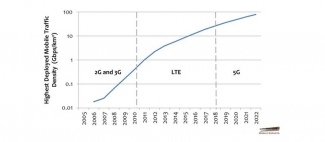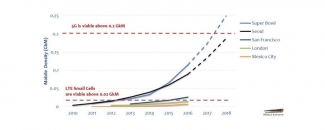
I’ve watched mobile data density grow by orders of magnitude over the years. In the good old days of voice communications, nobody really talked about data density. LTE networks were introduced when data density reached a level of about 1 Gbps/km2. We’re watching for the next transition point. Based on our cost models, we believe that the transition to mobile 5G will make economic sense when LTE traffic density reaches about 20 Gbps/ km2.

How do we figure this out? From 2011 through 2015, we watched the development of small cells and realized that operators with less spectrum have to deploy small cells earlier. We invented a tracking metric that we refer to as GkM, to look at mobile density in terms of Gbps/ km2/ MHz. In Korea and Japan, when the operators crossed a threshold of 0.02 GkM they started using small cells. This has been proven multiple times in networks across the world…when density reaches this threshold, it’s best to supplement the macro network with a small cell layer.
Put simply, if the network only needs coverage, macro is the answer. For dense capacity, small cells should be added. What happens when density increases by another 10X?
The simple-minded answer is that we will need 10X as many small cells. But that’s too darn expensive. There will be a level of traffic density at which a new air interface makes more sense than brute force.
The Mobile Experts model for 5G deployment estimates the cost of a 5G network and the potential revenue from new 5G services such as fixed wireless. Based on our model, it’s clear that deploying a fully mobile nationwide 5G network is economic suicide today. There is simply not enough high-density demand for that. Instead, we can predict a positive ROI for pockets of 5G coverage in congested places, and in fixed wireless applications.

Think about the fixed broadband wireless environment. If you have data demand for several HD video streams in a suburban neighborhood today, an LTE small cell is still the right answer. A 5G system would be underutilized, even with 20 HD streams within range of the small cell. However, if you assume that 4K video is coming along, as well as more exotic applications, then by 2018 it may be more cost effective to deploy a 5G small cell instead of multiple LTE small cells. (Don’t forget that we still need devices. The 2018 scenario is based on fixed wireless based on device availability.)
The Super Bowl is a good test case for hyper-dense networks. The 2016 Super Bowl was set up with a very advanced DAS system with a densified network surrounding the stadium. Mobile density reached 0.12 GkM during the event, with about 15 TB of data. Yee Haw! For the 2018 Super Bowl, the stadium needs an in-building network at 0.25 GkM, double the 2016 level. Will the mobile operators drop the ball?
I think that this analysis highlights the single most important thing about 5G: It will be an expensive solution for very high density. It won’t be deployed everywhere… just in places where high density is needed. We should expect 5G to start with very targeted deployments and slowly migrate into broad mobile coverage.
Joe Madden is Principal Analyst at Mobile Experts LLC, a network of market and technology experts that analyze wireless markets. The team provides detailed research on Small Cell, Base Station, Carrier Wi-Fi, and IoT markets. Mr. Madden currently focuses on trends in 5G, IoT, and Enterprise markets for wireless infrastructure. Over 26 years in mobile communications, he accurately predicted the rise of Digital Predistortion, Remote Radio Heads, Small Cells, and the rise of a Mobile IT market. He validates his ideas with mobile and cable operators, as well as semiconductor suppliers to find the match between business models and technology. Mr. Madden holds a Physics degree from UCLA. Despite learning about economics at Stanford, he still obeys the laws of physics.

